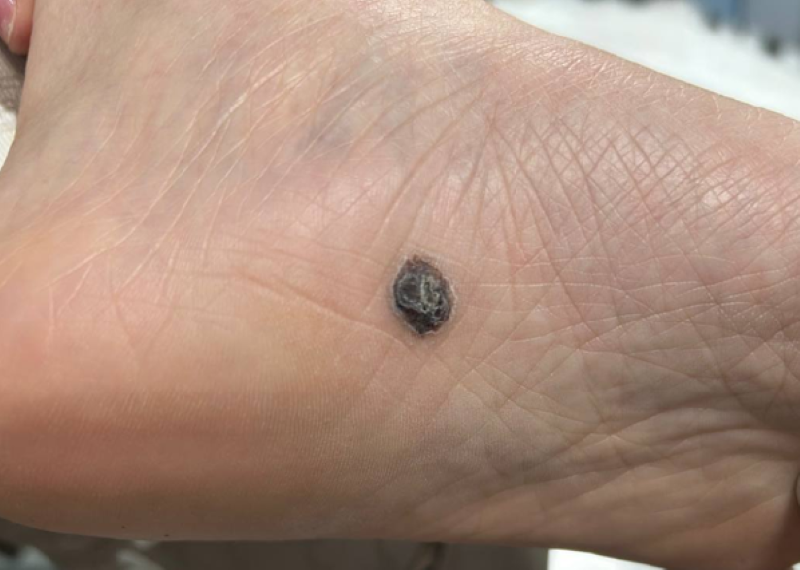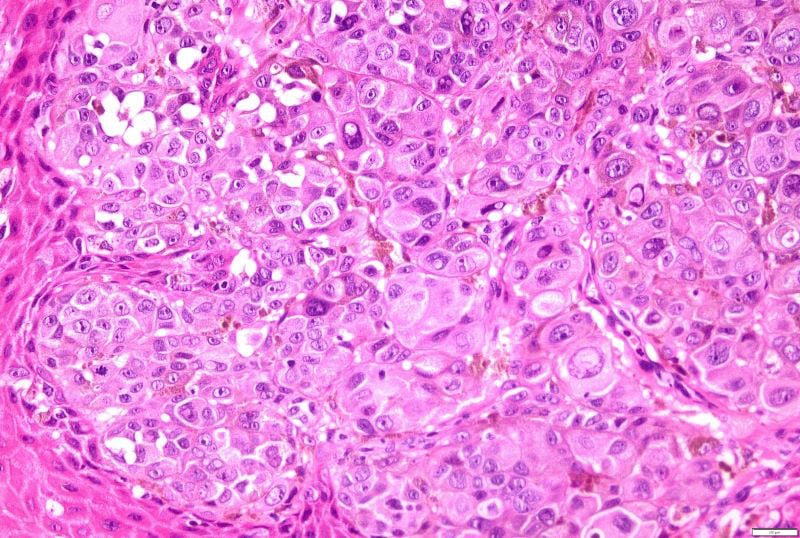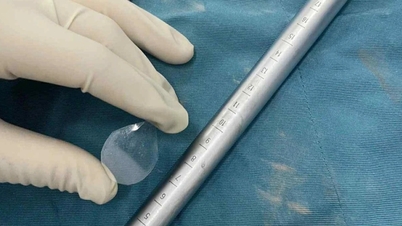
Mole under the patient's left sole with many abnormalities - Photo: Provided by the hospital
On April 29, MEDLATEC General Hospital ( Hanoi ) announced that it had just admitted Ms. CTHN (47 years old, Hanoi) who had melanoma, but for a long time thought it was just a normal mole on the bottom of her foot.
Recently the mole started to get bigger and the surface became rough, so she went to the hospital for a check-up and found out she had melanoma.
Ms. N. said that recently she discovered that the mole on the sole of her foot was increasing in size. Realizing the abnormality, she decided to go to the hospital.
With the doctor's experience, through clinical examination, the malignant nature of the mole was detected with the following signs: about 1cm in size, asymmetrical, rough brown-black surface.
The patient was indicated by the doctor for total tumor resection for histopathological evaluation.
Histopathological analysis results showed that tumor cells had malignant characteristics such as large, polymorphic nuclei, red nucleoli, scattered mitotic nuclei, cytoplasm containing melanin pigment, invading the epidermis and reaching the reticular dermis.
These characteristics led the pathologist to diagnose melanoma. To confirm the diagnosis and differentiate it from other malignant tumors, Ms. N. was further instructed to undergo immunohistochemical staining on the surgical specimen.
The tumor results revealed melanoma markers such as S100, HMB45, Melan A. The doctor diagnosed the patient with melanoma.
Currently, after tumor removal surgery, Ms. N's health is stable. The doctor advised on follow-up and scheduled a follow-up appointment after 3 months.

Histopathological examination images of the patient showed results pointing towards a diagnosis of melanoma - Photo: Provided by the hospital
What are the signs that a mole is at risk of malignancy?
Doctors say that on the human body, there often appear congenital or acquired skin lesions such as freckles, moles, changes in skin pigmentation...
Most of these lesions are benign, however, in some cases these lesions can transform into malignant form, so it is necessary to monitor their progression.
Accordingly, signs to recognize moles at risk of malignancy include:
1. Asymmetry: Moles are usually round or oval, with two sides symmetrical, but moles with a risk of malignancy have two sides that are not symmetrical.
2. Abnormal borders : Benign moles have soft, rounded borders, but atypical moles have borders that are map-shaped, zigzag, and irregular.
3. Inconsistent color: Instead of being just brown or black, moles that are at risk of malignancy may have dark spots, light spots, black, brown, red, blue, or pigment loss.
4. Large size: Common moles are less than 6mm in size. Moles larger than 6mm are considered to have risk factors.
5. Abnormal development : For moles with the risk of malignancy, the time it takes to change from small to large is very short. In just a few months, the mole can increase several times.
6. In addition, there are some other characteristics such as: ulcers, bleeding, rough surface, itching or pain...
In addition to visual recognition to identify suspicious signs, people need to immediately go to reputable medical facilities to perform necessary imaging tests to serve as a definitive diagnosis.
Source


![[Photo] Hanoi morning of October 1: Prolonged flooding, people wade to work](https://vphoto.vietnam.vn/thumb/1200x675/vietnam/resource/IMAGE/2025/10/1/189be28938e3493fa26b2938efa2059e)
![[Photo] Keep your warehouse safe in all situations](https://vphoto.vietnam.vn/thumb/1200x675/vietnam/resource/IMAGE/2025/10/1/3eb4eceafe68497989865e7faa4e4d0e)
![[Photo] President of the Cuban National Assembly visits President Ho Chi Minh's Mausoleum](https://vphoto.vietnam.vn/thumb/1200x675/vietnam/resource/IMAGE/2025/10/1/39f1142310fc4dae9e3de4fcc9ac2ed0)

























































































Comment (0)